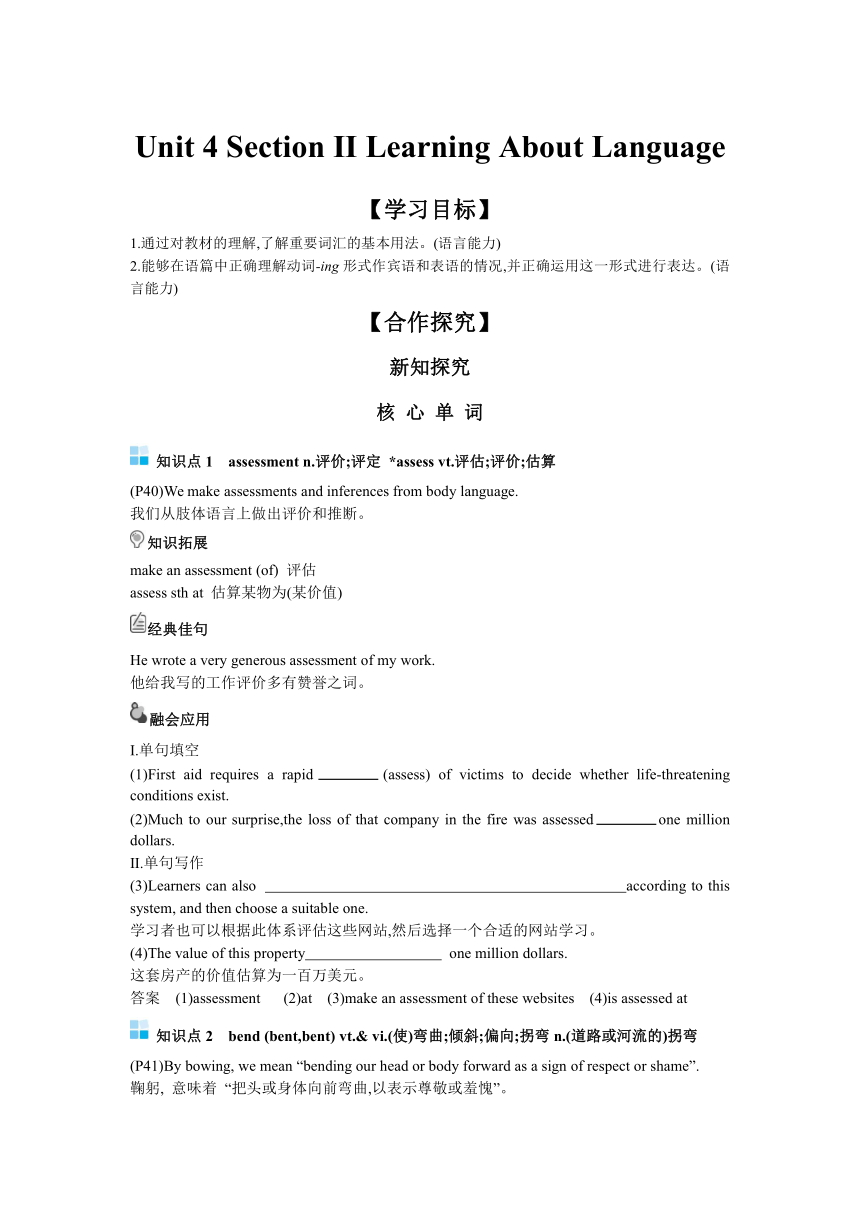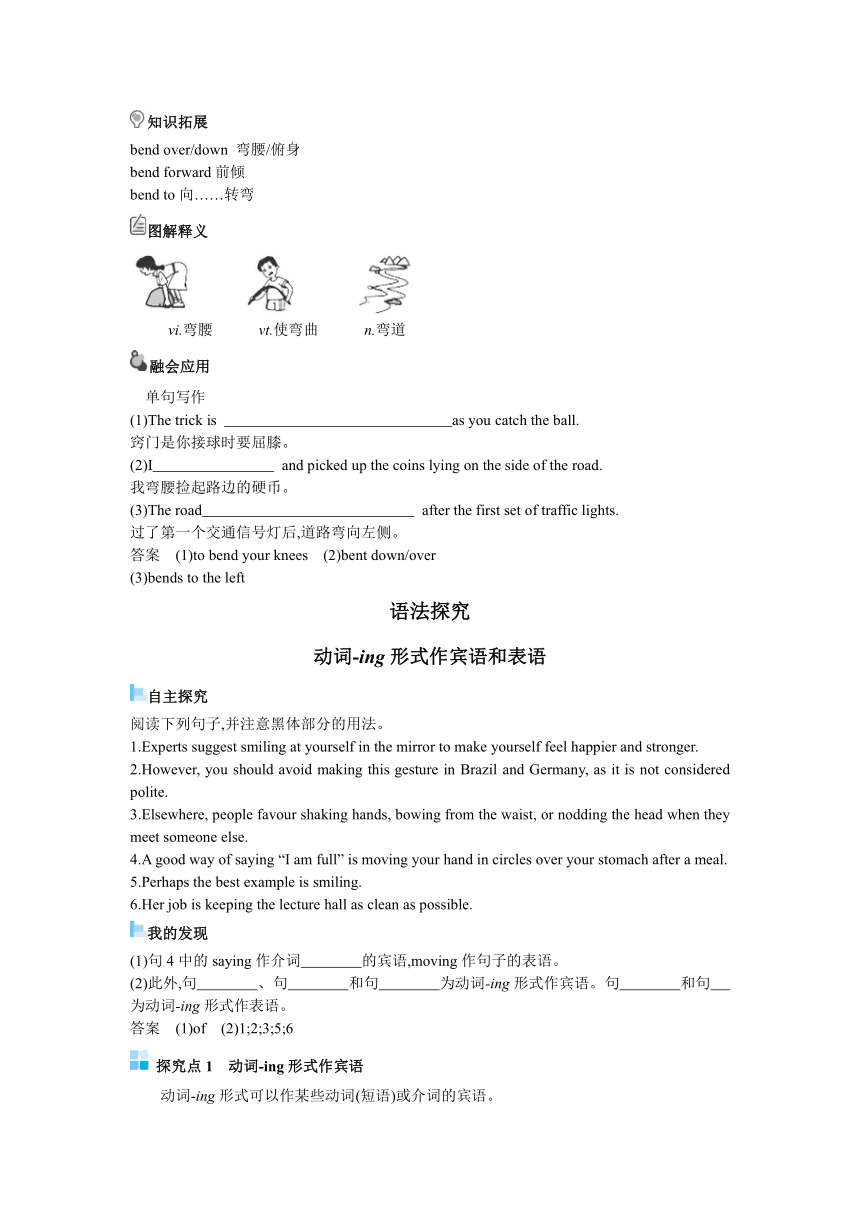人教版(2019)选择性必修 第一册Unit 4 Body Language Learning About Language 学案(含答案)
文档属性
| 名称 | 人教版(2019)选择性必修 第一册Unit 4 Body Language Learning About Language 学案(含答案) |  | |
| 格式 | docx | ||
| 文件大小 | 52.5KB | ||
| 资源类型 | 教案 | ||
| 版本资源 | 人教版(2019) | ||
| 科目 | 英语 | ||
| 更新时间 | 2024-04-07 19:13:04 | ||
图片预览


内容文字预览
Unit 4 Section Ⅱ Learning About Language
【学习目标】
1.通过对教材的理解,了解重要词汇的基本用法。(语言能力)
2.能够在语篇中正确理解动词-ing形式作宾语和表语的情况,并正确运用这一形式进行表达。(语言能力)
【合作探究】
新知探究
核 心 单 词
知识点1 assessment n.评价;评定 *assess vt.评估;评价;估算
(P40)We make assessments and inferences from body language.
我们从肢体语言上做出评价和推断。
知识拓展
make an assessment (of) 评估
assess sth at 估算某物为(某价值)
经典佳句
He wrote a very generous assessment of my work.
他给我写的工作评价多有赞誉之词。
融会应用
Ⅰ.单句填空
(1)First aid requires a rapid(assess) of victims to decide whether life-threatening conditions exist.
(2)Much to our surprise,the loss of that company in the fire was assessedone million dollars.
Ⅱ.单句写作
(3)Learners can also according to this system, and then choose a suitable one.
学习者也可以根据此体系评估这些网站,然后选择一个合适的网站学习。
(4)The value of this property one million dollars.
这套房产的价值估算为一百万美元。
答案 (1)assessment (2)at (3)make an assessment of these websites (4)is assessed at
知识点2 bend (bent,bent) vt.& vi.(使)弯曲;倾斜;偏向;拐弯n.(道路或河流的)拐弯
(P41)By bowing, we mean “bending our head or body forward as a sign of respect or shame”.
鞠躬, 意味着 “把头或身体向前弯曲,以表示尊敬或羞愧”。
知识拓展
bend over/down 弯腰/俯身
bend forward前倾
bend to向……转弯
图解释义
vi.弯腰 vt.使弯曲 n.弯道
融会应用
单句写作
(1)The trick is as you catch the ball.
窍门是你接球时要屈膝。
(2)I and picked up the coins lying on the side of the road.
我弯腰捡起路边的硬币。
(3)The road after the first set of traffic lights.
过了第一个交通信号灯后,道路弯向左侧。
答案 (1)to bend your knees (2)bent down/over
(3)bends to the left
语法探究
动词-ing形式作宾语和表语
自主探究
阅读下列句子,并注意黑体部分的用法。
1.Experts suggest smiling at yourself in the mirror to make yourself feel happier and stronger.
2.However, you should avoid making this gesture in Brazil and Germany, as it is not considered polite.
3.Elsewhere, people favour shaking hands, bowing from the waist, or nodding the head when they meet someone else.
4.A good way of saying “I am full” is moving your hand in circles over your stomach after a meal.
5.Perhaps the best example is smiling.
6.Her job is keeping the lecture hall as clean as possible.
我的发现
(1)句4中的saying作介词 的宾语,moving作句子的表语。
(2)此外,句 、句 和句 为动词-ing形式作宾语。句 和句 为动词-ing形式作表语。
答案 (1)of (2)1;2;3;5;6
探究点1 动词-ing形式作宾语
动词-ing形式可以作某些动词(短语)或介词的宾语。
Would you mind turning down your radio a little, please
请把你的收音机音量调小一点儿,好吗
I crossed the street to avoid meeting him, but he saw me and came running towards me.
我横穿街道以便避开他,但他看到了我并朝我跑了过来。
In their spare time,they are interested in planting vegetables in their garden.
在业余时间,他们对在他们的花园种植蔬菜感兴趣。
1.习惯上接动词-ing形式作宾语的动词:
admit承认 advise建议 stand忍受
permit允许 forbid禁止 appreciate感激
avoid避免 consider考虑 delay推迟
deny否认 enjoy喜欢 escape逃脱
excuse原谅 finish完成 imagine想象
keep保持 mind介意 miss 错过
practise练习 risk冒险 suggest建议
resist抵制 dislike不喜欢 fancy设想
2.接动词-ing形式作宾语的短语:
put off推迟
insist on坚持
feel like想要
depend/rely on依靠
object to反对
lead to导致
succeed in 在……方面成功
be worth值得
devote oneself to献身于
look forward to期盼
give up放弃;戒掉
pay attention to注意
stick to坚持
apply oneself to致力于
owing to归因于
get down to认真对待
be/get used to习惯于
be fond of喜欢
be good at擅长
what/how about ……怎么样
be busy (in) doing sth 忙于做某事
can't help doing sth 忍不住做某事
spend...(in) doing sth 花费……做某事
have difficulty/trouble (in) doing sth 做某事有困难
3.下列动词及动词短语后跟动词-ing形式和不定式都可以,但意义不同。
go on to do sth 做完一件事后,接着做另外一件事
go on doing sth 继续做原来做的事情
regret to do sth 对将要做的事表示遗憾
regret doing sth 对已经做过的事情感到后悔或遗憾
remember to do sth 记得去做某事
remember doing sth 记得曾经做过某事
forget to do sth忘记去做某事
forget doing sth 忘记曾经做过某事
stop to do sth 停下来去做另一件事
stop doing sth 停止正在做的事情
try to do sth 努力去做某事
try doing sth尝试着去做某事
mean to do sth 打算做某事
mean doing sth意味着做某事
can't help to do sth不能帮助做某事
can't help doing sth忍不住(或无法抑制)做某事
be used to do sth被用来做某事
be used to doing sth习惯于做某事
注意:
动词-ing形式作宾语时,其逻辑主语往往是句中的主语,但是如果要明确动作的执行者,也可以在动词-ing形式前加上名词所有格或形容词性物主代词表示逻辑主语。
I can't imagine John's giving a speech in front of so many people.
我无法想象约翰会在这么多人面前发言。
探究点2 动词-ing形式作表语
作表语的动词-ing形式包括现在分词和动名词。
1.现在分词作表语,往往具有形容词的性质,说明主语的性质、特征等。
He remained standing beside the table.
他仍然站在桌子旁边。
作表语的现在分词,许多是由能够表示人们某种感情或情绪的动词变化而来的。常见的有moving、 interesting、 encouraging、 disappointing、entertaining、exciting、 inspiring、 boring、 surprising、 puzzling、 amusing、 astonishing等。这类分词一般意为“令人……的”,通常用来修饰物。
2.动名词作表语多表示抽象性的或习惯性的动作,一般说明主语的内容。
For a sudden heart failure,the single best chance for survival is having someone nearby step in and do CPR quickly.
对于突发的心力衰竭, 最好的生存机会就是让身边的人参与其中, 快速做心肺复苏。
My hobby is collecting stamps.
我的爱好是集邮。
注意:
动词-ing形式作表语时,其逻辑主语往往是句中的主语,但是用作表语的动词-ing也可以有自己的逻辑主语。
What worries me most is his staying up late every night.
最让我担心的是他每天熬夜到很晚。
【随堂检测】
【夯实基础】
Ⅰ.单句填空
1.It is true that her job is (teach) English.
2.He was deeply affected because the story was very (move).
3.I am looking forward to (hear) from you soon.
4.I appreciate your (help) me out of the trouble.
5.The trees need (water).
6.I enjoyed (sit) close to the windows and looking at the view.
7.Later I became used to (talk) with people from various cultures.
答案 1.teaching 2.moving 3.hearing 4.helping
5.watering 6.sitting 7.talking
Ⅱ.翻译句子
1.他说的话听起来更有说服力。
2.帮助他人意味着帮助你自己。
3.如果你能坚持每天早上读英语报纸,那么你的英语水平将会提高。
4.听起来好像有人在敲门。
5.主要的问题是你缺乏大量的练习。
答案
1.What he says sounds more convincing.
2.Helping others means helping yourself.
3.If you can keep reading English newspapers every morning, your English will be improved.
4.It sounds as if someone is knocking at the door.
5.The main problem is your not having practised a lot.
【学习目标】
1.通过对教材的理解,了解重要词汇的基本用法。(语言能力)
2.能够在语篇中正确理解动词-ing形式作宾语和表语的情况,并正确运用这一形式进行表达。(语言能力)
【合作探究】
新知探究
核 心 单 词
知识点1 assessment n.评价;评定 *assess vt.评估;评价;估算
(P40)We make assessments and inferences from body language.
我们从肢体语言上做出评价和推断。
知识拓展
make an assessment (of) 评估
assess sth at 估算某物为(某价值)
经典佳句
He wrote a very generous assessment of my work.
他给我写的工作评价多有赞誉之词。
融会应用
Ⅰ.单句填空
(1)First aid requires a rapid(assess) of victims to decide whether life-threatening conditions exist.
(2)Much to our surprise,the loss of that company in the fire was assessedone million dollars.
Ⅱ.单句写作
(3)Learners can also according to this system, and then choose a suitable one.
学习者也可以根据此体系评估这些网站,然后选择一个合适的网站学习。
(4)The value of this property one million dollars.
这套房产的价值估算为一百万美元。
答案 (1)assessment (2)at (3)make an assessment of these websites (4)is assessed at
知识点2 bend (bent,bent) vt.& vi.(使)弯曲;倾斜;偏向;拐弯n.(道路或河流的)拐弯
(P41)By bowing, we mean “bending our head or body forward as a sign of respect or shame”.
鞠躬, 意味着 “把头或身体向前弯曲,以表示尊敬或羞愧”。
知识拓展
bend over/down 弯腰/俯身
bend forward前倾
bend to向……转弯
图解释义
vi.弯腰 vt.使弯曲 n.弯道
融会应用
单句写作
(1)The trick is as you catch the ball.
窍门是你接球时要屈膝。
(2)I and picked up the coins lying on the side of the road.
我弯腰捡起路边的硬币。
(3)The road after the first set of traffic lights.
过了第一个交通信号灯后,道路弯向左侧。
答案 (1)to bend your knees (2)bent down/over
(3)bends to the left
语法探究
动词-ing形式作宾语和表语
自主探究
阅读下列句子,并注意黑体部分的用法。
1.Experts suggest smiling at yourself in the mirror to make yourself feel happier and stronger.
2.However, you should avoid making this gesture in Brazil and Germany, as it is not considered polite.
3.Elsewhere, people favour shaking hands, bowing from the waist, or nodding the head when they meet someone else.
4.A good way of saying “I am full” is moving your hand in circles over your stomach after a meal.
5.Perhaps the best example is smiling.
6.Her job is keeping the lecture hall as clean as possible.
我的发现
(1)句4中的saying作介词 的宾语,moving作句子的表语。
(2)此外,句 、句 和句 为动词-ing形式作宾语。句 和句 为动词-ing形式作表语。
答案 (1)of (2)1;2;3;5;6
探究点1 动词-ing形式作宾语
动词-ing形式可以作某些动词(短语)或介词的宾语。
Would you mind turning down your radio a little, please
请把你的收音机音量调小一点儿,好吗
I crossed the street to avoid meeting him, but he saw me and came running towards me.
我横穿街道以便避开他,但他看到了我并朝我跑了过来。
In their spare time,they are interested in planting vegetables in their garden.
在业余时间,他们对在他们的花园种植蔬菜感兴趣。
1.习惯上接动词-ing形式作宾语的动词:
admit承认 advise建议 stand忍受
permit允许 forbid禁止 appreciate感激
avoid避免 consider考虑 delay推迟
deny否认 enjoy喜欢 escape逃脱
excuse原谅 finish完成 imagine想象
keep保持 mind介意 miss 错过
practise练习 risk冒险 suggest建议
resist抵制 dislike不喜欢 fancy设想
2.接动词-ing形式作宾语的短语:
put off推迟
insist on坚持
feel like想要
depend/rely on依靠
object to反对
lead to导致
succeed in 在……方面成功
be worth值得
devote oneself to献身于
look forward to期盼
give up放弃;戒掉
pay attention to注意
stick to坚持
apply oneself to致力于
owing to归因于
get down to认真对待
be/get used to习惯于
be fond of喜欢
be good at擅长
what/how about ……怎么样
be busy (in) doing sth 忙于做某事
can't help doing sth 忍不住做某事
spend...(in) doing sth 花费……做某事
have difficulty/trouble (in) doing sth 做某事有困难
3.下列动词及动词短语后跟动词-ing形式和不定式都可以,但意义不同。
go on to do sth 做完一件事后,接着做另外一件事
go on doing sth 继续做原来做的事情
regret to do sth 对将要做的事表示遗憾
regret doing sth 对已经做过的事情感到后悔或遗憾
remember to do sth 记得去做某事
remember doing sth 记得曾经做过某事
forget to do sth忘记去做某事
forget doing sth 忘记曾经做过某事
stop to do sth 停下来去做另一件事
stop doing sth 停止正在做的事情
try to do sth 努力去做某事
try doing sth尝试着去做某事
mean to do sth 打算做某事
mean doing sth意味着做某事
can't help to do sth不能帮助做某事
can't help doing sth忍不住(或无法抑制)做某事
be used to do sth被用来做某事
be used to doing sth习惯于做某事
注意:
动词-ing形式作宾语时,其逻辑主语往往是句中的主语,但是如果要明确动作的执行者,也可以在动词-ing形式前加上名词所有格或形容词性物主代词表示逻辑主语。
I can't imagine John's giving a speech in front of so many people.
我无法想象约翰会在这么多人面前发言。
探究点2 动词-ing形式作表语
作表语的动词-ing形式包括现在分词和动名词。
1.现在分词作表语,往往具有形容词的性质,说明主语的性质、特征等。
He remained standing beside the table.
他仍然站在桌子旁边。
作表语的现在分词,许多是由能够表示人们某种感情或情绪的动词变化而来的。常见的有moving、 interesting、 encouraging、 disappointing、entertaining、exciting、 inspiring、 boring、 surprising、 puzzling、 amusing、 astonishing等。这类分词一般意为“令人……的”,通常用来修饰物。
2.动名词作表语多表示抽象性的或习惯性的动作,一般说明主语的内容。
For a sudden heart failure,the single best chance for survival is having someone nearby step in and do CPR quickly.
对于突发的心力衰竭, 最好的生存机会就是让身边的人参与其中, 快速做心肺复苏。
My hobby is collecting stamps.
我的爱好是集邮。
注意:
动词-ing形式作表语时,其逻辑主语往往是句中的主语,但是用作表语的动词-ing也可以有自己的逻辑主语。
What worries me most is his staying up late every night.
最让我担心的是他每天熬夜到很晚。
【随堂检测】
【夯实基础】
Ⅰ.单句填空
1.It is true that her job is (teach) English.
2.He was deeply affected because the story was very (move).
3.I am looking forward to (hear) from you soon.
4.I appreciate your (help) me out of the trouble.
5.The trees need (water).
6.I enjoyed (sit) close to the windows and looking at the view.
7.Later I became used to (talk) with people from various cultures.
答案 1.teaching 2.moving 3.hearing 4.helping
5.watering 6.sitting 7.talking
Ⅱ.翻译句子
1.他说的话听起来更有说服力。
2.帮助他人意味着帮助你自己。
3.如果你能坚持每天早上读英语报纸,那么你的英语水平将会提高。
4.听起来好像有人在敲门。
5.主要的问题是你缺乏大量的练习。
答案
1.What he says sounds more convincing.
2.Helping others means helping yourself.
3.If you can keep reading English newspapers every morning, your English will be improved.
4.It sounds as if someone is knocking at the door.
5.The main problem is your not having practised a lot.
